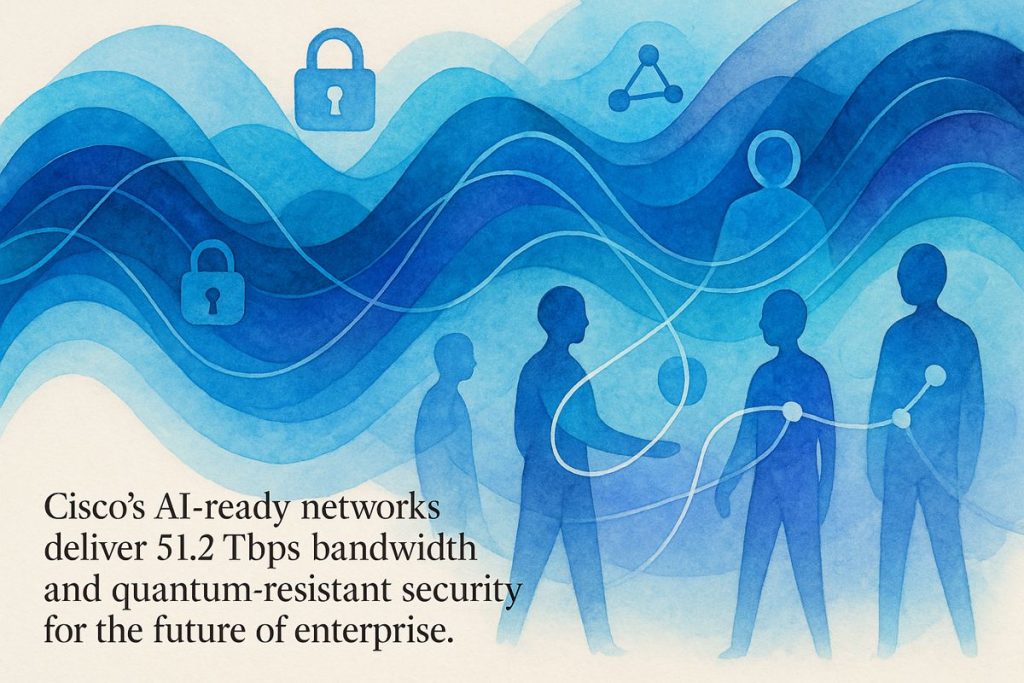Cisco’s 2025 networking upgrades are a massive leap forward, built to handle the explosive rise of AI. Their new hardware is super fast—like a river of data—offering up to 51.2 Tbps and lightning-quick responses, all while being wrapped in tough, quantum-resistant security. Automation by AI (AgenticOps) helps the network fix itself before problems grow, almost like magic. With deeper analytics and always-on security, Cisco’s network is ready to protect and power the next wave of smart technology.
What are the key features of Cisco’s 2025 enterprise networking upgrades for AI workloads?
Cisco’s 2025 enterprise networking upgrades deliver up to 51.2 Tbps throughput, sub-5-microsecond latency, quantum-resistant security, and seamless orchestration for AI workloads. Key features include advanced routers and switches, AI-powered AgenticOps automation, integrated Zero Trust security, and deep analytics via Splunk integration.
The New Shape of Enterprise Networks
If you stand in a datacenter these days—let’s say one in the aromatic hum of San Jose—you can almost smell the ionized ozone of change. Cisco’s latest enterprise networking upgrades, rolled out for 2025, aren’t just another notch in the company’s long belt of incremental hardware refreshes. No, they’re more like a tectonic plate shift, engineered precisely to carry the swelling tide of AI workloads. I had to stop and ask myself: Is this just marketing bravado, or is there substance under the hood?
Turns out, there’s more than just sizzle. With global AI adoption charting an upward curve that would make even Schrödinger’s cat envious, and nearly every Fortune 500 company onboarding AI-infused apps, Cisco’s decision to refactor its architecture is less a bold gamble and more an inevitability. The goal? To supply not only bandwidth (think up to 51.2 terabits per second—try visualizing that as a river of data wider than the Volga) but also the low-latency, bulletproof security, and orchestration muscle that AI workloads now demand. In the coming years, it won’t be enough for networks to hold up under pressure—they’ll need to dance, nimbly, as petabytes surge and recede.
I still remember a time, not too long ago, when just getting all the printers on the same subnet felt like a triumph. Now, the stakes are exponentially higher, and downtime could cost upwards of $160 billion globally per major outage. Stings a bit, doesn’t it?
Hardware That Doesn’t Just Hum—It Roars
Let’s drill down. The twin engines of Cisco’s new lineup—the 8100–8500 series routers and Catalyst 9350/9610 switches—are veritable hyperspectral marvels, designed for the hyperscale era. If you’re thinking in terms of numbers, these machines clock in at that aforementioned 51.2 Tbps throughput and sub-5-microsecond latency. That’s a blink-and-you’ll-miss-it interval, ideal for the sensory ballet of distributed AI model training and inference pipelines.
Security, of course, can’t be left in the dust. The hardware now houses quantum-resistant cryptographic modules, a nod to looming threats posed by quantum computing. (Honestly, I once scoffed at quantum encryption in a meeting, only to be schooled by a cryptanalyst from MIT—lesson learned: tomorrow’s threats arrive faster than you’d think.)
And let’s not forget that Cisco, in the tradition of Silicon Valley’s pantheon—NVIDIA comes to mind—has forged alliances with neocloud juggernauts to ensure seamless interplay between its gear and hyperscale AI data centers. The result? An ecosystem that feels less like a patchwork quilt and more like a unified fabric, tough as Kevlar and nimble as silk.
AgenticOps, or How I Learned to Stop Worrying and Love AI Automation
Now, here’s where things get a little more palimpsestic. Cisco’s unified management platform, AgenticOps, puts an LLM at the helm—a Deep Network Model trained to orchestrate, troubleshoot, and optimize at machine speed. I’ll admit: the first time I handed over root access to an AI agent, I felt a twinge of apprehension (call it low-grade dread). But after watching it slice through tedious root cause analysis like a hot knife through butter—proactively fixing issues before they snowballed—I felt something I hadn’t expected: relief. Sweet, caffeinated relief.
The system doesn’t just automate; it seems to anticipate, learning the pulse of your network and tuning it with the precision of a Stradivarius violin. It’s here that the analogy to an orchestra really works: AI handles the dissonant notes and ensures harmony across the board, so your IT team isn’t stuck playing whack-a-mole with tickets at 3 a.m.
Anecdotally, there was this time last April—network anomaly at a client site in Frankfurt. Pre-AgenticOps, it would’ve taken us hours (and several pots of bitter office coffee) to track down the rogue process. With automation, the issue was flagged, triaged, and neutralized before I even had a chance to hit “refresh.” Bam! The future, evidently, is already here.
Security and Quantum Shadows: Fortifying the AI Citadel
Of course, with great power comes even greater attack surfaces. Cisco’s security enhancements aren’t just afterthoughts bolted onto the chassis; they’re woven into the stack, like threads of tungsten carbide. The Hybrid Mesh Firewall and Universal Zero Trust Network Access (ZTNA) modules deliver granular, always-on security—think of them as ever-vigilant gatekeepers, verifying every packet, every user, every device, every time.
This is crucial, given the rise of “agentic” AI—those autonomously acting bots that can be as capricious as a Dostoevsky antihero. As the threat landscape morphs, Cisco’s security operations dig deeper with Splunk, which, since its acquisition in 2024, adds another hyperspectral layer of analytics and real-time threat detection. I recall feeling a frisson of satisfaction watching Splunk’s dashboards light up, a little like the city skyline at dusk—illuminating, yes, but also a reminder of what’s at stake.
Quantum-resistant protocols? They’ve moved from science fiction to boardroom necessity. As quantum computers loom like storm clouds on the horizon, Cisco’s adoption of these cryptographic standards signals a rare moment of industry foresight. Will it be enough? Time will tell…but I’d rather
